Lupine Publishers | Current Investigations in Agriculture and Current Research
Abstract
The Borana Pastoralists are known as major cattle supplier of cattle for domestic and international markets, yet the benefits they get from the sector is said to be minimal. This study, therefore, was initiated to identify market chain actors and their function in the market, investigate the structure Conduct and performance of live cattle in Moyalle District of Borana Zone. Both primary and secondary data were used for this study. Primary data were collected from 223 sampled pastoralists, 25 traders and 14 brokers. Before the household survey, key informant interview and focus group discussions were conducted using 10 producers, 5 traders and 3 brokers. Descriptive Statistics and qualitative data analysis techniques were employed to analyze the cattle market structure, conduct and performance. The result shows that producers, brokers, traders and consumers were the major cattle market actors. Two major channels identified in the area were formal and informal. Both the channels are also characterized by their sub-channels.
Among the formal channels, formal market channel is identified as the preferable marketing channel with better total final price share for producers. Regarding the market structure, cattle market is known to be dominated by few traders. Although the degree of competition varies, cattle market structure varies across cattle type marketed from loose oligopoly to strict oligopoly. This shows that only few traders share the majority of market share and earn abnormal profit. Besides, cattle market is characterized by entry barriers such as distant market point, high trucking cost, seasonality of marketing, information asymmetries and unfriendly relation between actors. These imperfect nature of the market in the district provoked informal trade. As the pastoralists mainly depend on cattle for their livelihoods and other cultural values, traders take advantage of the asymmetric market information towards them. Although it varies with the type of cattle, the larger share of the market gains remains with end of traders thereby limiting the pastoralists a chance to realize the economic gains in cattle production. Hence, linking producers to market and its benefits, establishing in cooperatives and development of infrastructure could play a significant role for optimization of the sector productivity.
Keywords: Cattle; Market chain; Pastoralists; Structure; Conduct performance
Introduction
Marketing is the answer to the underdevelopment of developing countries. When adopted and practiced, marketing will help to develop appropriate technologies as developing nations provide for the needs of the people and enhance their standard of living, create job opportunities, wealth for entrepreneurs, a means towards affording education and enjoyment of leisure [1]. In the Borena Area, cattle predominantly flow in a South to North direction, regardless of their market channel [2]. However, the Borena pastoralists are known as the major cattle suppliers for domestic consumption and international trade export, till yet they could not able to be benefited from the sector due to impediments. The lengthy marketing process, high transaction cost, informal cattle trade and the like has been one of major obstacles that caused country to lose a lot of foreign currency. In addition to these, over exploitation of brokers, weak and unfriendly linkage in between the major marketing actors, lack of market-oriented cattle production is some of the main challenges.
To improve the competitiveness of cattle in pastoralist area cost-effective marketing channels and coordinated market chains, which reduce the transaction costs among different actors along the chain are crucial [3]. Majority of cattle marketing information in the pastoralist level is outdated, unreliable and as the result it couldn’t able to provide the real picture of the economic contribution of pastoralists sector for the country economy and the community engaged in the sector. More over these, the critical problem in cattle marketing sector stands in the course of formulating appropriate policies and procedures for the purpose of increasing marketing efficiency in the sector. For the pastoralists’ community undertaking research on structure conduct and performance of cattle is believed to enhance its productivity by locating economical cattle marketing routes. Available evidence shows that limited numbers of investigations have been made on local and regional cattle markets in pastoralist area and the market chain is dominated by many brokers at primary, secondary and terminal markets [4].
Most studies of market chain tend to focus on market chain of the cattle at aggregate level than dealing the market chain of individual cattle types. The present studies try to link this gap by disaggregating the cattle into various types to see the market chain opportunities and problems for each type of cattle separately. Therefore, this study will provide relevant information with respect to the value chain of various cattle types by
a) Identifying the major market actors and their function of cattle market,
b) Identifying the marketing channels,
c) Examining the market structure, conduct and performance.
Methodology
The Borana administrative zone is situated in Ethiopia’s Oromia regional state and located in Southern part at about 570 km (Yabalo town) from Addis Ababa. The capital of Borana zone is Yabello [5]. The Borana zone is made up of 13 districts, divided between two agro-ecological zones, the semi-arid lowlands to the south and the more humid lands at higher altitudes to the north [6]. Moyale is one of the Woredas in the Oromia regional state. It is located 770 km south of Addis Ababa. The Woreda has an area of 14,810 km2 and it is divided into 18 kebele 2 of which are located in Moyale town [7]. It splits the two countries: the larger portion being in Ethiopia (in the Oromia Region and Somalia region) and the smaller in Kenya (i.e. the capital of the Moyale district). It is a busy market for both informal and formal trade of food commodities and livestock [8]. In this study both secondary and primary data was used from different sources. Journals, books, proceedings, CSA and ESAP publications were secondary data sources that used in the study. Primary data sources include Pastoral household interview, traders’ interview, brokers interview and key informant interview.
The study used commodity chain analysis (CCA), which involves mapping the market chains, involved in particular production sectors, different types of activity, geographical location and actors in different roles at different levels. The major market costs considered in the study include, cost transporting, brokering cost, marketing levies and taxes imposed by local authorities [9]. For this particular study two stage sampling techniques was used. Factors like number of live-stock kept, income difference, gender, age of pastoralists, major function of actors in cattle marketing, proximity to major marketing centers and other important economic variables were important issued while selecting the representative households in the districts. The producers interviewed in the study were pastoralists. Both traders and brokers were selected purposely and interviewed. The random probability sampling techniques was used for selecting the representative producer households from the area.
Two stages sampling technique was used for selection of pastoralists Kebele identification that made through secondary data of pastoralists development office. Three Kebeles from the pastoralist area were considered in the survey. Respondent sample size per each Kebele was determined proportionally to the number of total households in the area. The sample size determination techniques employed was Rule of Thumb Techniques that estimate by using the following formula:100% for 0-100 populations,10% for101-1,000 populations, 5% for 1,001-5,000 poulations,3% for 5,001-10,000 population and 1% for more than 10,000 respectively [10]. Based on this technique the sample size of pastoralists household interviewed from respective kebels, Maddo, Maddo Miggo and Laga Sure were 100, 63 and 60 respectively. The survey study at woreda level considered 167 male (74.9%) and 56(25.1) female household heads. The sample size of male and female household heads interviewed in Maddo kebele was 78(78%) and 22(22%).
The number male and female respondents interviewed in Laga Sure kebele was 45(75%) and 15(25%). From whole interviewed respondents in Maddo Miggo Kebele 69.8% (44) was male and 30.2% (19) female. The sample size of traders and brokers was 25 and 14. Descriptive statistical analysis such as mean, mode, percentage and standard deviation of important economic variables considered in collecting information was used to analyze data. Data was analyzed using Statistical Package for Social science (SPSS Verstion.20) and Excel 2007. Besides, qualitative data obtained from focus group discussion, key informant interviews and observations were categorized into similar themes, looked for relationships and interpreted.
Results and Discussions
Socio-Economic Characteristics of Pastoralists
The average age of the Pastoralists household head was 42. However, it ranges in between 20 and 81. The majority of them (96.9%) are in economically active age group in the age range of 20 and 65 years. The family size distribution Table 1 shows that the average family size of Moyalle pastoralists is 7 but it ranges between 2 and 25. The majority of the households have medium and large family size. Those households with very large family size are characterized by polygamous family. The small family size households were young couples. Table 2 revealed that 81.2 percent of sampled households did not attend formal education whereas; the proportion of pastoralist household who attended formal education was 18.8%. The distribution of pastoralist households with respect to formal education attendance shows that less than one fifth they attended formal education. However, study by [11] in Yabello district shows that the proportion of pastoralists who attended formal education is by far greater (41.7 %).
This could be due to the fact that the Moyalle District pastoralists area are less accessed to market capacity development services and infrastructures in relation to other districts in the Borana zone. The majority of households owned cattle in the range between 4 - 12 (45.29%) cattle per head. These are poor category households. This is closely followed by medium category households 43% and own 13 - 43 heads of cattle. The rich and very rich households’ own cattle heads that range from 44-56 and 57-109 respectively. However, the proportion of these households is less that 3 percent. Other study by [12], however, revealed that from the total respondents’ pastoralists in Yabello area about 7 percent were reported to be rich, 10 percent medium, 17 percent poor, and 66 percent were destitute. The socioeconomic profile of cattle traders shows that all (100%) of them were male with a mean age 39.44 years that range between 23 and 60 years. The result shows that all the cattle traders are in the bracket of active age category.
Unlike the pastoralist’s category, the proportion of the traders who attended formal education is nearly two third (64%). This means that about 36% cattle traders were illiterate, 20% attended primary school (grade 1 to 4) and 36% attended junior school (grade 5 to 8) and 8% attended secondary high school (grade 9 up to 10) respectively. This implies that in cattle trading, the importance of education cannot be over-emphasized, for it determines information dissemination and technology adoption among marketers in diverse socio-economic and biophysical environment [13]. Contrary to their education profile, the majority of the traders (52 percent) were with trading experience of less than five years. This reveals due to the infrastructure and development of policy that is relevant to cattle trade, currently attracting more traders. The study results (Tables 3 & 4) observed confirmed also that the mean trading experience for sampled traders in the area was 7.64 years. The general trading experience of interviewed traders ranges between 2 to 20 years. The percent of cattle marketers that had marketing experience ranging from 2 to 5 years, 6 to 9 years and 10 to 13 were 52%, 12% and 16% respectively. The proportion of cattle marketers that had marketing experience of 14 to 17 years and 18 to 20 were 12% and 8% respectively. Hence, the results revealed that majority of cattle traders in the area are highly experienced.
Structure Conduct and Performance of Cattle Marketing
Market Structure of Cattle
a) Major Actors and Their Function in Cattle Market
Cattle market structure in Moyalle district of Borana zone is characterized by diverse actors including pastoralists, local collectors, brokers, traders, hotels and restaurants. Each actor has its own function. Pastoralists are the first actors of in the market chain of cattle. Some of major duties and responsibilities of pastoralists include supplying healthy and quality cattle. Brokers are important actors in the market chain of cattle and they play facilitation of market process, market information provision, price setting, and acting as delegates of traders such as making agreement between sellers and buyers [14]. Traders’ role is purchasing, price setting, giving final market price, controlling marketing process and market information provision.
b) Major Channels
With respect to marketing channel, both formal and informal cattle marketing channels exist in the area. As traders pay taxation fee for respected organization in the chain, cattle traveled to central Ethiopia referred as formal market channel. But, Cattle traders those trek cattle from Ethiopia to Kenya do not paying tax and transport through unknown route, the specific market chain defined as informal market channel. Both channels are dominant as in relation to proximity and long-lived history, pastoralists are accustomed to informal market channel. The formal market channel is a newly developed one and it has different sub channels.
Channel I:Pastoralist-Broker-Small Trader-Formal exporter. This cattle market channel is one of formal market channel and practiced by few pastoralists. Here, pastoralists sell to brokers and brokers sell to small traders. The small traders purchase from brokers and resale to formal exporters that come from central Ethiopia cities. Due to infrastructural development and relatively better security in current years, this market channel developed newly in the district. This sort of cattle market channel is experienced by about 5% pastoral households and observed as new opportunities.
Channel II: Pastoralist-Broker-Collectors-Informal Exporter. In this cattle market channel pastoralists sell their cattle to brokers and brokers sell to collectors. Here, collectors purchase cattle from brokers and resell to informal exporters. This market channel has long life history in the district and used to be the only route of cattle marketing before five to ten years ago. This channel is experienced by about 46% of pastoralists’ households in the district.
Channel III: Pastoralist-Collectors-Informal Exporter. This cattle market channel is one of usual market channel. Brokers are not used as mediator in but the small/medium traders in this market channel purchase from producers directly and resell to informal exporters. The proportion of sampled pastoral households accustomed to use this sort of cattle market channel amounts to 4%.
Channel IV: Pastoralist-Brokers-formal Exporter. In this channel the producers sell cattle to brokers and brokers sell cattle to formal exporters and experienced by 2% of pastoralists. This cattle market chain was also identified as newly introduced chain to the area. This sort of market chain should be appreciated and have to be due attention to boost production and productivity of cattle [15]. Here, producers undertake cattle marketing through broker mediating process to other formal exporters and consumers. Ethiopian universities and air lines institutions that come seldom to the area are some listed formal cattle buyers.
Channel V: Pastoralist-broker-informal trader. This market channel is one of channel that identified as informal. Here, Pastoralists sell cattle to brokers and brokers sell to informal exporters that come from Kenya. The proportion of interviewed pastoralists that are engaged in this type of cattle market amounts 2%.
Channel VI: Pastoralists-Other Pastoralists. In this cattle market channel pastoralists sell cattle to other pastoralists and it is known for restocking and usually undertaken around farm gate. The major aim of this market chain is replacing the aged cattle. The proportion of pastoralists that depend on this type of cattle market channel amounts to 12%. Cattle category marketed in this channel comprised of calves, heifer and bulls. Pastoralist households undertake marketing activity in this route by friendship, kinship and neighborhood pattern.
Channel VII: Pastoralists-Broker-Festival Consumer. This channel is one of the oldest and informal institutional based channels. Here the producers sell cattle to other producers, consumer traders, urban dwellers and newcomers from surrounding highlands. The purpose of buyers of cattle is for festival consumption. The proportion of pastoralists households take part in this cattle market channel is 14% of interviewed pastoralists.
Channel VIII: Pastoralists-Broker-Butchers. This is also referred as newly developed value addition channel that formed due to existence of smuggling activity and settlement of peoples from other areas for this activity. Out of interviewed respondents Pastoralist 15% of the households of sell cattle to brokers and brokers resell the cattle to butchers. this is also referred as newly developed cattle market channel that created in recent years as new market opportunities due to mobilization of peoples to the surrounding and smuggling activity that become job opportunities for majorities. This result tells about how the cattle market chain complicated by lengthy routes that hinder not to exploit the resource at pastoralists district by producers and tilted the market toward informal trade. This study calls for systematic intervention for cutting off unnecessary market route and adopting legalized market channel toward the vicinity African countries. As indicated in the (Table 5) above (5) the market structure shows distinctive features according to cattle type marketed. Market structure for oxen, heifers and calves trade is tight oligopoly but it is a loose oligopoly for cows and bulls trade. Since heifers and calves are often marketed among pastoralists and rarely by informal traders and not by formal traders, the market structure is tight oligopoly.
In addition to these, calves are unable to trek long distance in the marketing route, they are not preferred by market actors. The market structure for oxen trade tight oligopoly, because pastoralists supply at bull and oxen are usually demanded only in limited festivals. The implication of this is that market actors want ox at bull stage in order to exploit value added in the chain and easily trek/truck the bulls. Consequently, traders in the area undertake marketing activity having been closely creating market relation so as to exploit benefits that belongs to producers. In addition to these, bulls trade encompasses various market actors such as informal traders, formal traders, hotels and restaurants and festival consumers, the market structure is relatively loose oligopoly. The cow trade is also including various market actors such as pastoralists and informal exporters; its market structure is loose oligopoly. This point out that tight oligopoly reduces competition and the entire market remains a “few traders game” where created wealth does not flow to all the beneficiaries in equitable ratio. Arguably, it should again be noted that failure to enjoy such benefits may distort market operations and eventually lead to collapse of the cattle production system. This calls for systematic government intervention in the sectors that could mitigate imbalance of trade benefits and help to optimize productivity through market linkage formation, adoption of value addition and development, update market information provision and cooperative formation.
c) Entry and Exit Conditions in the Cattle Market
The long market distance from pastoral areas to central towns of Ethiopia and the related high trucking cost, high capital demand, institution-based marketing and information asymmetries are some of the major entrance and exit barriers in cattle trade in the area. The number of cattle supplied to market in holidays, religious festivals and weeding occasions are also higher than that of other seasons. In order to undertake marketing activity directly; it is must to speak local language. So as to take part in cattle trade, it is also must secure large amount capital for purchasing cattle, trucking and trekking.
Market Conduct
Market Conduct refers to the strategies adopted by a player as a way of adjusting to the market conditions in order to fully enjoy the market benefits. Notably, it includes mechanisms such as price setting and terms of payment.
a) Price Setting Mechanisms
The price setting activity of cattle in pastoralist area is known to be accomplished by various actors in the market. About 62% of pastoralists confirmed that price of cattle is set by brokers based on initial price given by sellers and final price from buyers. The proportion of pastoralists recognized determination of price by buyers based on central market information, by brokers based on central area information and sellers by their own respectively is 22%, 10% and 6%. This shows that market actors had different level of influence in the role they played for setting price. It is observed that every aspect of price setting mechanism majorly is controlled by traders. This means that price setting in cattle market is often skewed toward traders and brokers. The result indicates that traders undertake non-price competitions including cattle type, trade experience, personality, financial capacity and language. The implications of this market structure are few potential traders’ accounts for large market share, market dominance by these top four traders, interdependency and collusion possible.
b) Terms of Payment for Producers
Both the household survey and key informant interview reveals that the cattle marketing by pastoral households has been undertaken in inform of cash or hand by hand currency. The proportion of producers who indicated cattle marketing carried out in the form of direct cash payment is 96%. The remaining 4% of the pastoralists marketed both in credit and hand in hand cash payment before three to five years. This justified that almost all producers market their cattle inform of direct cash transfer in current years. The main reason for ceasing of cattle trade in form of credit from previous years to current is loss of certain capital due to credit. This means that market actors in the area assured that before five-year certain informal traders had purchased cattle in form of credit did not repay the credit back. This phenomenon had ceased credit marketing system in the district.
Market Performance
Market performance refers to the impact of structure and conduct as measured in terms of variables such as prices, costs, and volume of output. Analysis of the level of marketing margins and their cost components could help to evaluate the impact of the structure and conduct characteristics on cattle market performance. The marketing margin of cattle is the difference between the revenue from the sales of cattle and the costs incurred in running the market operation. The net marketing margin of cattle (NMM) is also the percentage over the final price earned by the intermediary as his net income once his marketing costs are deducted and is one of the best tools to analyze performance of cattle market. Marketing margin was calculated taking the difference between producers and formal exporter or informal trader prices. Mathematically, producers share expressed as: PS=Pp/Pt = 1-MM/Pt where PS=producers share, Pt=price of traders, and MM= market margin.
In general, producer’s share of final price in formal channel higher than that of informal, which points out that formal route is preferable for them. Since traders and brokers obtain relatively better market margin in informal route, it is difficult to compete for formal traders with informal traders in the district. In contrary to free market economy, market concentration ration and market margin estimated for cattle market shows oligopolistic nature. It therefore means that the formal or informal market cattle traders do not bare full cost involved in the market thereby leading relatively low marginal costs. This is to mean that the cattle market is disintegrated in such a manner that price levels does not relay from the cattle keepers to the terminal market traders. Indeed, it is observed that the principle of free market through bargaining is distorted once a new market entrant is discovered. For example, buying at a relatively fair price requires one to have known the local language at the farm gate market, security and cattle type marketed (non-price competition).
This means that without close relation with the market brokers; one is subjected to price discrimination. Since the market is flooded by brokers at all the chain terminals; it is very difficult to assess the efficient market price and general information. It was observed that there exists larger number of market brokers both for different live cattle and in many cases; the brokers hold much needed information so as maximize on the commissions. Monopoly market structure violates the principle of equity between the traders and the pastoralists. This is because the larger share of the market gains remains with end of chain traders thereby denying pastoralists a chance to realize the economic gains in cattle production.
Comparison of Market Margin Across Cattle Type and Marketing Channels
The market performance of cattle marketed varies across cattle type marketed and the type of channel used. The empirical result in Tables 2 & 6 indicates that the cow traders earn highest net market margin but, calve traders earn lowest net market margin in formal channel. The level of net market margin earned in informal channel is highest for ox traders, while it is lowest for calves. The proportion of producer share of final cattle price from informal market channel is 18% lower than that of formal. This indicates that it is advisable for producers to market cattle though formal channel, while it is good for trader to use informal channel that is well developed in value addition practices and linked to the largest east Africa market point, Nairobi, which by its own make difficult to compete for formal traders with informal channel that has higher market margin (Table 6).
Conclusion
Almost all market structure of cattle in the area shows the noncompetitive nature. The market concentration ratio for top four cattle trader is ranged between 43.03 and 95.02. The estimated HI index is between 1013.39 and 2702.31. This concentration ratio indicates that the market structure of cattle is imperfect, and the competition is among the few traders. This few large traders share majority of market share and earn abnormal profit. This could be one of the suspected reasons for producers for shifting from cattle to camel and small ruminants and low productivity of the sector. Hence, it is must for systematic government intervention to minimize exploitation benefits by trader’s that belongs to producers through cooperative establishment. For each cattle type there are formal and informal market channels. Among the channels the first formal channel was identified as the preferable marketing channel that has higher and better total final price share for producers. The monopoly nature of the terminal cattle market denies the efficient market principles that forces producers not to optimize productivity.
The analysis of the marketing costs and margin revealed that brokers incurred the lower marketing cost and traders the higher marketing cost in all cattle type. The market cost of trader and broker in informal market channel is higher than formal. Marketing margin of traders and brokers is different along different channels. Traders and brokers get relatively better profits in informal channels. This could be the reason for most traders to participate in informal channel. The producers’ share of final of cattle is relatively better in formal channel for producers. The study indicated that it is better for producers to sale cattle at formal channel, where they could optimize their benefits through cooperative and reduced transaction costs. By summing up, contrary to free market economy, market concentration ratio and margin estimated shows oligopolistic nature. It therefore means that the formal or informal market traders mainly for cattle do not bare full cost involved in the market thereby leading relatively low marginal costs.
By intuition therefore, it means that the cattle market is disintegrated in such a manner that price levels does not relay from the cattle keepers to the terminal market traders. The monopoly power in this case lies with the informal traders who are at the end of the chain. Since the pastoralists purely depend on cattle for their livelihoods, it was noted that traders take advantage of the market information to exploit the keepers through price discrimination. It was observed that there exists larger number of market brokers both for different live cattle and in many cases; the brokers hold much needed information so as maximize on the commissions. It is also observed that monopoly market structure violates the principle of equity between the traders and the pastoralists. This is because the larger share of the market gains remains with end of traders thereby denying pastoralists a chance to realize the economic gains in cattle production.
Read More Lupine Publishers Agriculture Journal Article:


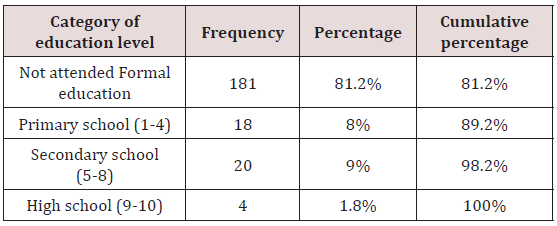
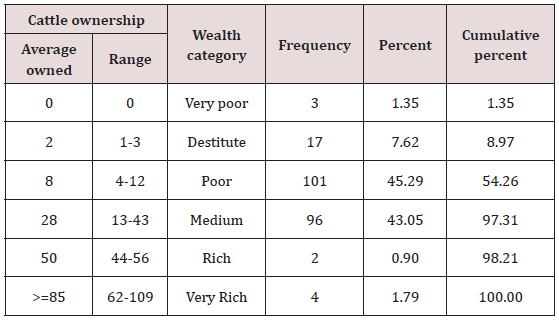

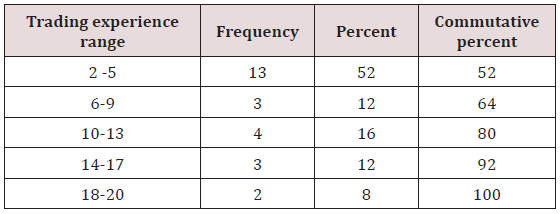
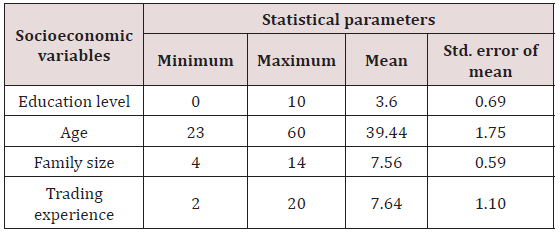
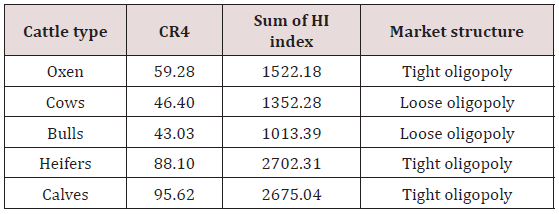

No comments:
Post a Comment
Note: only a member of this blog may post a comment.